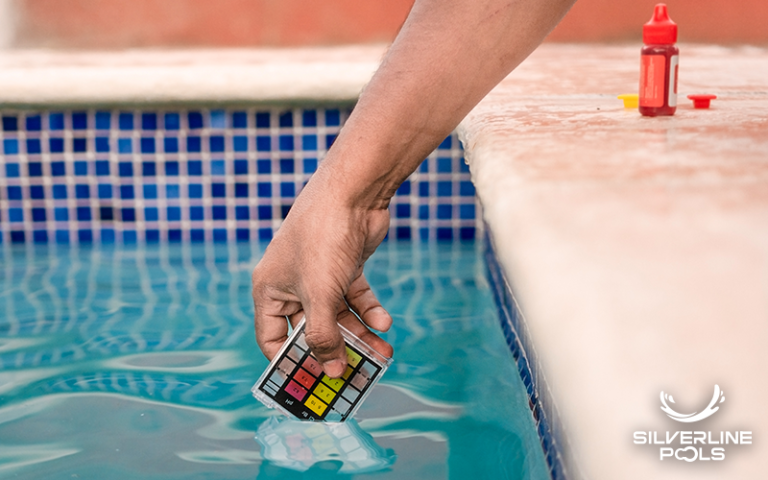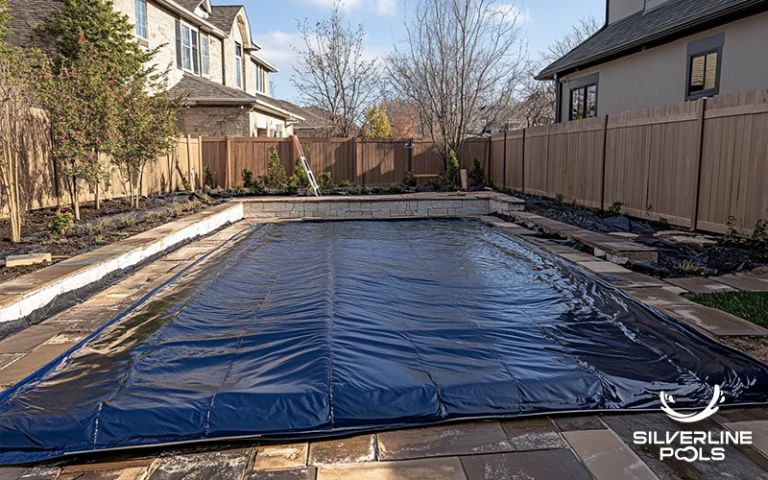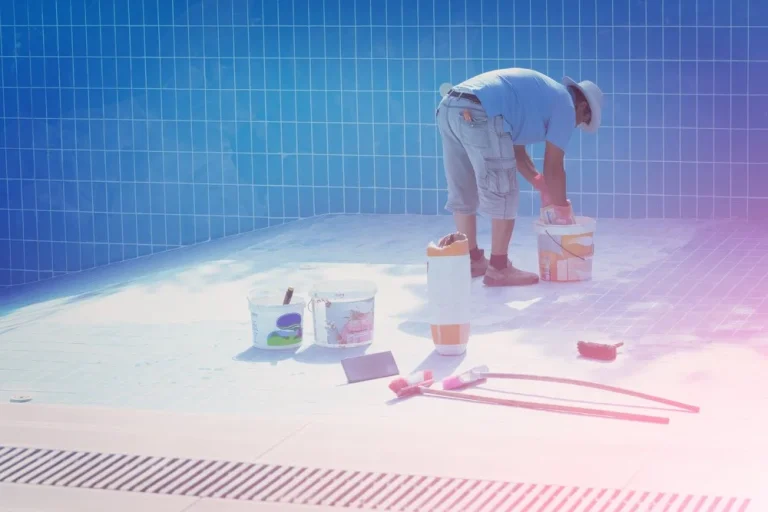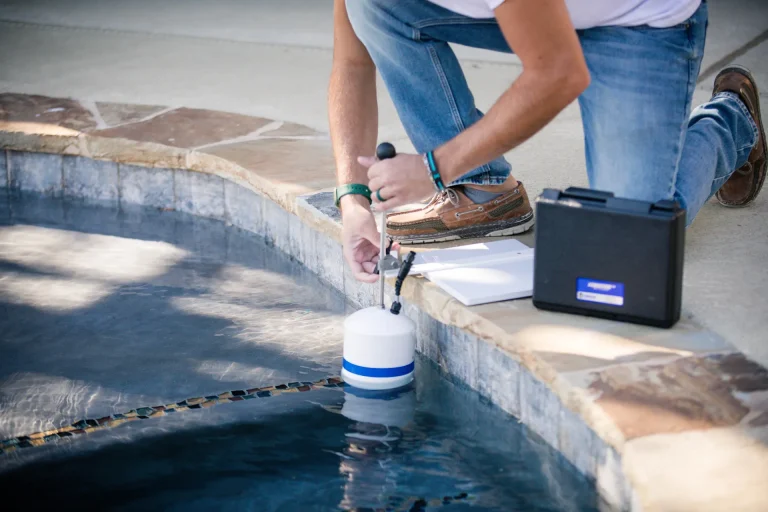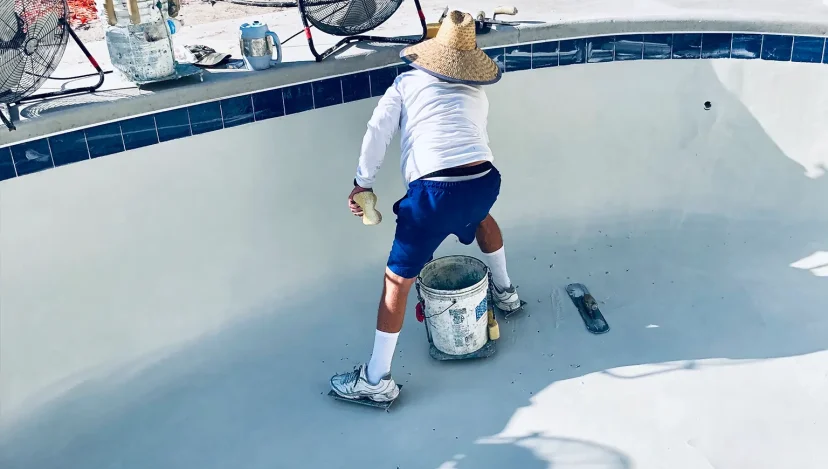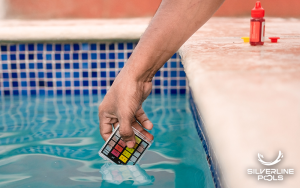Over time, wear and tear can damage your pool’s aesthetics, making it look worn-out and unappealing. This is where pool painting comes to the rescue. Pool painting is important for maintaining its beauty and functionality. It is also necessary to have the right painting tools and follow the safety precautions for painting a pool.
This blog is a 10-step guide for how to paint your pool. It also covers the benefits of pool painting, the right amount of paint needed for your pool, and the precautions to follow during the painting process.
Let’s jump into your pool painting guide!
What equipment and materials will you need during pool painting?
Before starting pool painting, knowing the required pool equipment and materials is necessary. Here is a list of equipment and materials needed during a pool painting:
Equipment/Tools
- Roller frame
- The 3/8-inch lambskin roller cover
- 3.5-inch paint brush
- Nylon-bristle cleaning brush
- Roller extension pole
- Submersible pump
- Discharge hose
- Nylon rope
- Pool brush
- Shop vacuum
- Tarp or sheet plastic
- 5-in-1 tool
Materials
- Rubber-based pool paint
- Mineral spirits or paint thinner
- Citrus-based degreaser/cleaner
- Epoxy Pool Filler
What are the precautions to follow before painting your pool?
Painting your pool needs proper care and attention. Here are some precautions for painters regarding the pool while painting it. For a safe and effective painting of your pool, here are some safety precautions for the painters:
- Always use rubber gloves and protective goggles.
- Follow safety precautions when power equipment is.
- Work in a well-ventilated area.
- Never mix chemicals.
- Use slip-resistant shoes.
What are the recommended conditions for pool painting?
Following are some recommended conditions for pool painting:
- Avoid painting your pool directly in the sunlight.
- It is best to paint in the morning.
- Consider the temperature range above 50°F and below 85°F when painting your pool.
- Ensure a 100% dry pool surface when applying the paint.
- Don’t paint the pool when you expect rain in 2 to 3 days.
How Much Paint to Use: Your Pool Paint Calculator
Have you ever wondered how much paint a professional pool maintenance company would use while painting your pool? The question is worth asking because pool paints are expensive, and a pool requires the right amount of painting.
Here is the general pool paint calculator for using the right amount.
| Pool Surface Area | Paint Required (Gallons) |
| 300 sq. ft. | 3 |
| 400 sq. ft. | 4 |
| 500 sq. ft. | 4 |
| 600 sq. ft. | 5 |
| 700 sq. ft. | 6 |
| 800 sq. ft. | 7 |
| 900 sq. ft. | 7 |
| 1000 sq. ft. | 8 |
| 1100 sq. ft. | 9 |
| 1200 sq. ft. | 9 |
| 1300 sq. ft. | 10 |
| 1400 sq. ft. | 11 |
How to Paint Your Pool in 10 Steps
The following are the simple steps for painting your pool:
- Drain and Clear Your Pool
- Removing Existing Pool Paint
- Fix Pool Cracks
- Clean with a Soapy Solution
- Acid Washing the Pool
- Abrade the Surface
- Apply Masking Tape
- Apply Your First Coat
- Apply Your Second Coat
- Let Your Pool Dry and Fill it
1. Drain and Clear Your Pool
First, drain your pool water to clear the pool surface. Because pool water contains chemicals, don’t drain it into plants, backyard grass, or a pit. Drain the pool water through a hose to a street gutter or sanitary sewer.
2. Removing Existing Pool Paint
Next, scrub your pool’s surface with a brush. Scrub up and down for the debris to loosen up and flow into the draining water. After the pool dries completely, scrape its walls and bottom to remove loose paint using a 5-in-1 tool. Use a nylon bristle brush to clean your pool and clear the debris through the hose.
3. Fix Pool Cracks
Removing paint will expose the pool’s cracks and crevices. Here is how to do it:
- Grind out pool cracks to a U-shape and fill them with hydraulic cement.
- For shallow defects, fill them with epoxy filler.
- For Deeper Holes (>10mm), fix them with sand/cement mix
4. Clean with a Soapy Solution
The pool needs degreasing to remove body oils and other organic residue. Use a soapy solution for this. Once the soap washing is completed, rinse again entirely with fresh water.
5. Acid Washing the Pool
The next step is acid-washing your pool. For this, prepare a solution of 50% water and 50% muriatic acid. After acid etching, neutralize your pool with a bicarbonate wash. Rinse your pool with fresh water.
6. Abrade the Surface.
Next, rub the pool surface. Roughening up (abrasion) the pool’s existing surface improves the adhesion of the new paint. Use a coarse (around 40-grit) sanding disc to abrade the pool surface.
7. Apply Masking Tape
Before applying new paint, mask your pool surface with tape treads to prevent paint from splattering tiles or pool fittings.
8. Apply Your First Coat
In this step, applying new paint starts. Here is how to do it:
- Make the pool paint a bit thin to enhance its penetration.
- Use a roller to apply paint to large surfaced pools.
- Use a paintbrush to reach the pool’s corners, edges, and around pool equipment.
- Leave it for at least 24 hours for effective results.
9. Apply Your Second Coat
Once the first coat of your pool paint has dried, apply your second coat. We recommend using the paint perpendicular to your first coat for the second coat. Try to address the hard-to-reach areas and corners of your pool.
10. Let Your Pool Dry and Fill it
Now, it’s time to let your pool completely dry for at least seven days in the summer and 14 days in the winter. Don’t add any chemicals. Once it is completely dried, fill it with fresh water. You are ready for your pool swimming fun again.
What are the advantages of pool painting?
Here are the benefits of pool paint:
1. Restores the Beauty of Your Pool
Over the years, your pool’s surface can become discolored, chipped, or faded due to exposure to sunlight, chemicals, and regular usage. However, professional pool painting can revive its beauty. The painting will provide a fresh coat covering imperfections and returning your pool’s vibrancy.
2. Enhances Pool Lifespan
Proper pool maintenance is essential to prolonging its lifespan. Using high-quality pool paint creates a protective barrier against chemicals, UV rays, and natural elements. This protective layer not only enhances the appearance of your pool but also ensures its longevity.
3. Slows Bacterial Buildup
Pool painting is an excellent way to control pool algae. The stubborn variants of pool algae, such as black algae, grow in the cracks and rough surfaces of the pool. Painting will fill these micro spaces, crevices, and rough corners and surfaces, making it hard for the algae to build and grow.
Silverline Pools: Your Best Pool Maintenance Company
Silverline Pools is your go-to pool maintenance, remodeling, and repair company. Whether it’s your new pool construction, servicing, or returning your outdated pool to a top-notch shape, you are always in safe hands with us.
Our team efficiently paints your brand-new pool and completely repaints or remodels it. Our budget-friendly pool painting services and on-time project completion sets us apart.
Final Thoughts
Painting a pool is an excellent way to enhance its lifespan and aesthetic looks and control algal growth. Pool painting needs specific equipment and materials during the painting process. Choosing the right amount of pool paint is crucial for any pool, and we recommend reading the guidelines on the paint box or can while painting your pool.
Silverline Pools is your best choice if you plan to paint your new pool or repaint your existing one. Contact their expert team and turn your ordinary-looking pool into the envy of the neighborhood.
Frequently Asked Questions
Can I paint my pool myself?
Yes, pool painting is a DIY project. You can paint your pool in 2 to 3 days. However, calling a professional such as Silverline Pools ensures quality painting with long-lasting effects.
What is the cheapest way to paint a swimming pool?
Applying chlorinated rubber pool paint is a wallet-friendly way to paint your pool.
How many paint coats does a pool need?
A pool needs 2 to 3 coats of paint typically.
How long does pool paint last?
The lifespan of pool paint depends on the weather conditions and the quality of the paint. However, the average life of pool paint is a couple of years.
What is the best color for pool paint?
The best pool paint color depends on your personal choice and style. However, some famous pool paint colors include Sapphire Blue, Crystal Blue, Aquamarine, and Diamond Sand.
Should I sand my pool before painting it?
Yes, you can sand your pool before painting it. Sanding your pool will make the pool surface and walls even for better paint application.
How often should I paint my pool?
The best idea for optimal pool functionality is to paint it every 5 to 7 years. However, you can paint your pool before this time period as required by its conditions.
How long do you let pool paint dry?
You should wait at least for 7 days before filling the pool. This will ensure proper curing and prevent damage to the paint.


